The Covid-19 pandemic has changed the way people shop. While ecommerce sales have been on the rise for years, the need to stay home accelerated the growth of online shopping in the U.S.
To learn more about today’s online shopping trends, we used a multi-pronged approach that included:
• A Survey: We surveyed over 1,000 people who regularly shop online (meaning at least once a week) to gain insights into current trends, especially as they relate to the new shopping landscape post-pandemic.
• Social listening data: We analyzed 30,000 Twitter posts from March 2021 to March 2022, and leveraged customized research from Meltwater to gain further insights about online shopping while drunk, online shopping regrets, and online grocery delivery.
Read on for the 13 most compelling online shopping trends we’re seeing today.
1. Social influence: People buy what they see on social media.
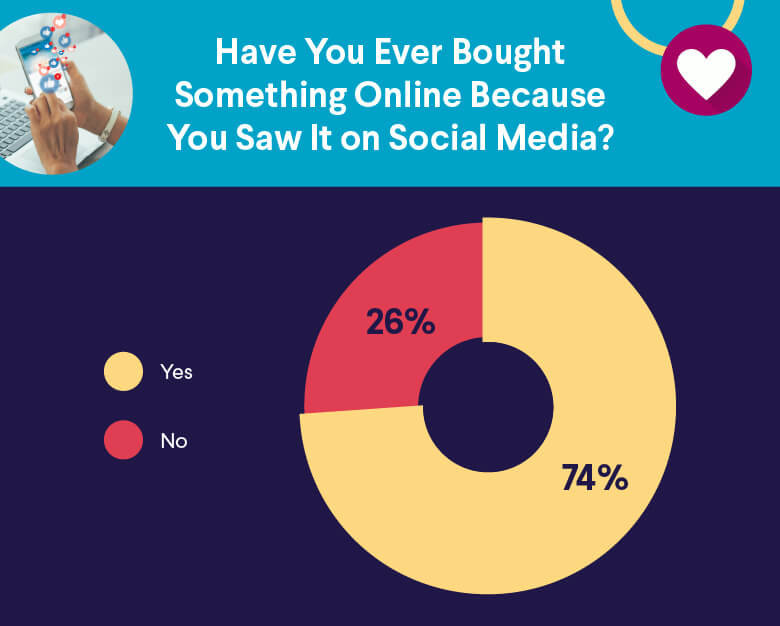
The power of social media as a purchasing tool can’t be overstated.
According to our research, 74% of respondents say they’ve bought something they’ve seen on social media platforms like TikTok, Instagram, and Facebook. In 2017, only 40% of adults said they’d bought something after seeing it on social media.
What’s more, men are more likely to make these purchases than women: 78% of men say they’ve purchased something they’d seen on social media, compared to 70% of women who say the same.
2. Buy now, think later: Most online purchases are impulse buys.

If you’ve bought something on the spot while browsing online, you’re not alone: 56% of people say that more than half of their online purchases are impulse buys.
Comparing age groups, millennials are the most impulsive online shoppers, with 63% of respondents saying their online purchases are not planned.
Gen Z may be the most prudent online shoppers. Of all the age groups, they had the highest percentage of respondents who said none of their online purchases are impulse buys (12%). Boomers, at 10%, were a close second.
3. At some point, most people shop online while not totally sober.
One interesting finding from our research: A majority (53%) of respondents admit they haven’t been sober when making an online purchase.
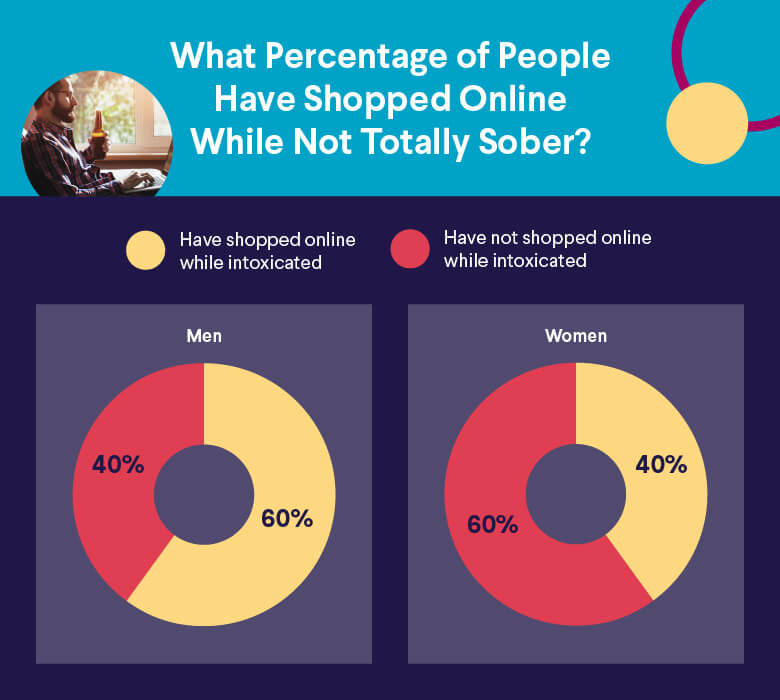
Men are more likely to shop while intoxicated than women, with 60% saying they’d shopped online while not sober, compared to 40% of women who said the same. When looking at age groups, millennials (60%) are most likely to shop while not sober, and Boomers (37%) are the least likely to do so.
Online shopping while drunk isn’t necessarily a private activity. Some shoppers have shared their intoxicated online shopping adventures on social media.
According to Meltwater data, there was a 496% increase in the number of Tweets about drunk online shopping from 2020 to 2022.
While our survey found men to be more likely to engage in drunk online shopping, women were more likely to post about their intoxicated online shopping experiences on social media. According to our social listening data, millennial moms and wives made up the largest cohort of Twitter users who posted about drunk online shopping.

Clothing was the most discussed shopping category in the social posts we analyzed. About 10% of people who mentioned drinking and online shopping discussed buying items for their children.
Amazon was by far the most mentioned shopping source (83%) in posts about drunk online shopping in which the name of the store was included.
People are most likely to talk about drunk online shopping on Saturday between 9am and 10am, and Sunday from 6am to 7am (possibly recounting the night before). Interestingly, Thursday morning between 10 and 11 is also a popular time to discuss drunk online shopping.
4. Beer is the top drink of choice for intoxicated online shopping experiences.
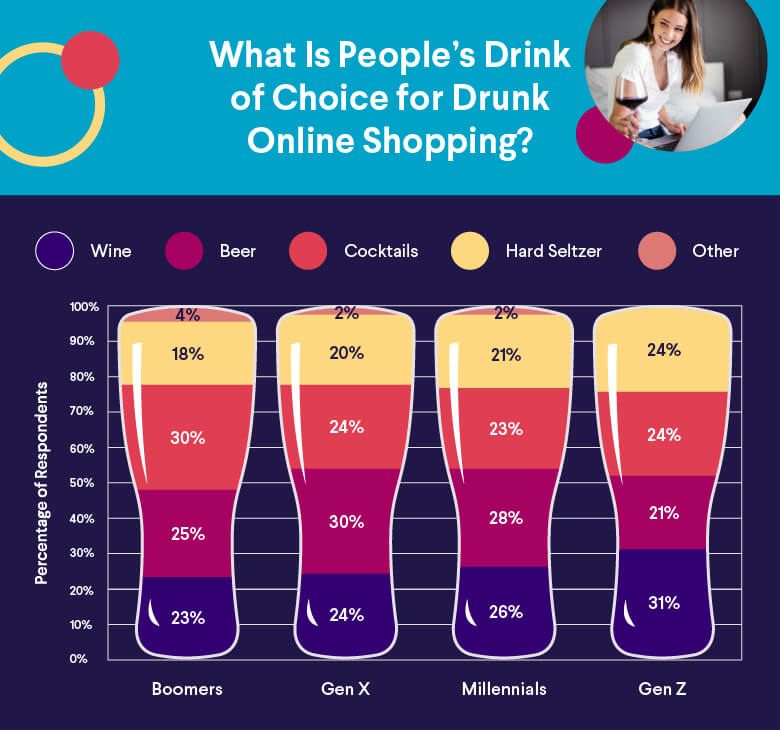
Beer is the top drink for drunk online shoppers, with 54% of respondents saying they typically consume it before an intoxicated shopping experience. Wine (52%) was a close second, followed by cocktails (47%), and seltzers (42%).
The drinks of choice vary by age group. The most popular drinks for each generation are:
• Boomers: Cocktails (30%)
• Gen X: Beer (30%)
• Millennials: Beer (28%)
• Gen Z: Wine (31%)
5. Shoppers may not remember purchasing something online until it arrives.

Have you ever forgotten ordering an item until it arrived on your doorstep? A full 65% of our survey respondents say they have.
Of all the age groups, millennials were the most likely to order something and forget about it, with seven out of 10 respondents saying that’s happened to them. Boomers were the least likely to forget making an online purchase.
6. Just because stores have reopened doesn’t mean people are coming back.
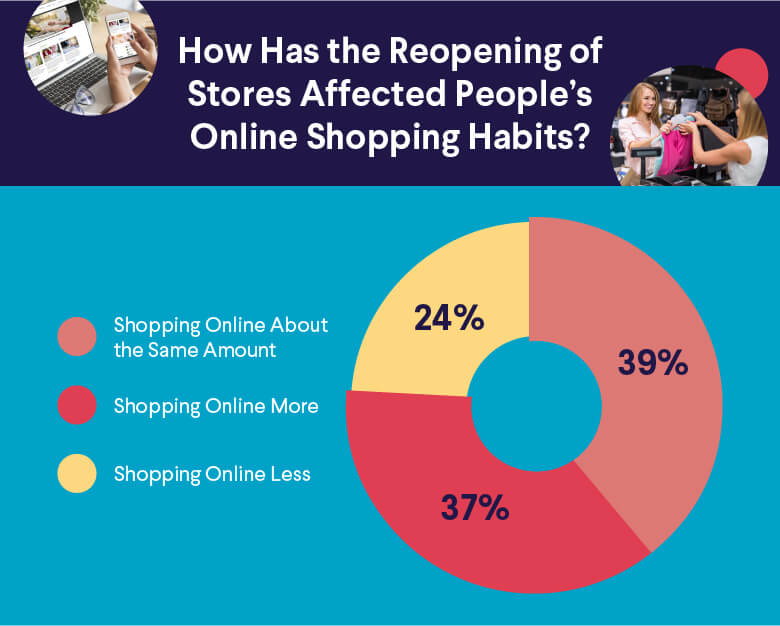
The pandemic caused a massive ripple in worldwide markets due to government shutdowns. Apparently, the reopening of stores hasn’t done much to convince consumers to return.
The percentage of Americans who have recently visited a mall is less than half of what it was pre-Covid. Before the pandemic, about 56% of Americans said they visited a mall within the last 30 days. Now, just 26% of respondents say they’ve shopped at a mall in the last month.
Even with stores reopening, 39% of consumers say they will continue shopping online the same amount, and 37% say they plan to shop online even more. In other words, a majority of people will maintain or increase the online shopping habit they picked up during the pandemic.
7. Men spend more online shopping now than they did pre-pandemic, compared to women.
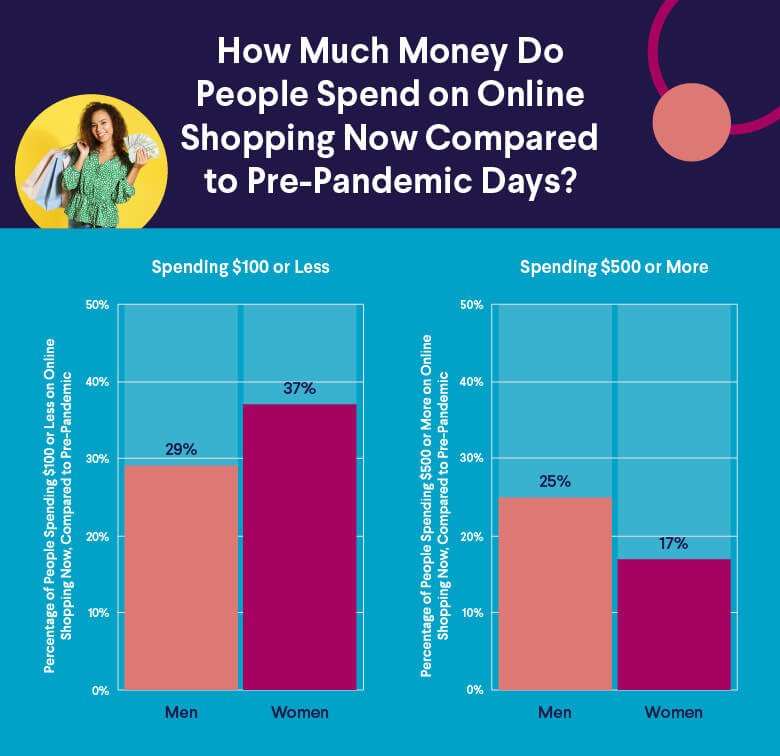
The pandemic has changed all kinds of consumer shopping habits, including the amount of money people spend online now versus what they spent before the pandemic. When comparing men and women, we found that:
• 25% of men are spending over $500 more on online shopping now than they did pre-pandemic
• 17% of women are spending over $500 more on online shopping now than they did pre-pandemic
• 37% of women are spending $100 or less on online shopping now compared to pre-pandemic days
• 29% of men are spending $100 or less on online shopping now compared to pre-pandemic days
8. People tend to order from Amazon at least three times per month.

People are ordering more from Amazon than ever before. The company’s profits increased 220% in 2021 from the previous year when the pandemic was in full effect.
A majority of respondents (65%) place three or more orders on Amazon each month. And 16% place more than five Amazon orders every month.
9. Shoppers are split on in-store vs. online clothes shopping.
Despite the convenience of online shopping, there was a near-even split between the percentage of people who prefer to shop for clothes online (52%) versus in-person (48%).
Boomers had the largest percentage of respondents (60%) who prefer to shop for clothes online. Gen Z had the largest percentage of respondents who prefer to shop for clothes in-person (55%).

While many online retailers have made it easier to return clothes, the inconvenience of having to ship items back may outweigh the inconvenience of having to drive to a store to try things on.
10. Items that look different online vs. in-person are a common source of purchase regret.

Buyer’s remorse is not new. However, with the rise of online shopping, we wanted to find out the most common reason people regret their online purchases specifically.
Apparently, it’s because items can look a lot better on-screen than in-person. The biggest reason our respondents regretted an online purchase was because they felt it looked different in real life compared to how it was presented online (26%). The second-most popular reason was overspending on an online purchase (22%).
Here’s a breakdown of the reasons people regret online purchases:
• It looked better on the screen than in real life – 26%
• I spent too much money on it – 22%
• I do not use or wear it – 14%
• It wasn’t what I wanted but I was too lazy to return it – 14%
• I meant to return it but missed the window for returns – 13%
• I don’t know what I was thinking when I bought it – 10%
When we analyzed social posts that discussed online shopping regrets, we found that the posters tended to be Gen Z women who are mothers, have dogs, and/or are writers or artists.
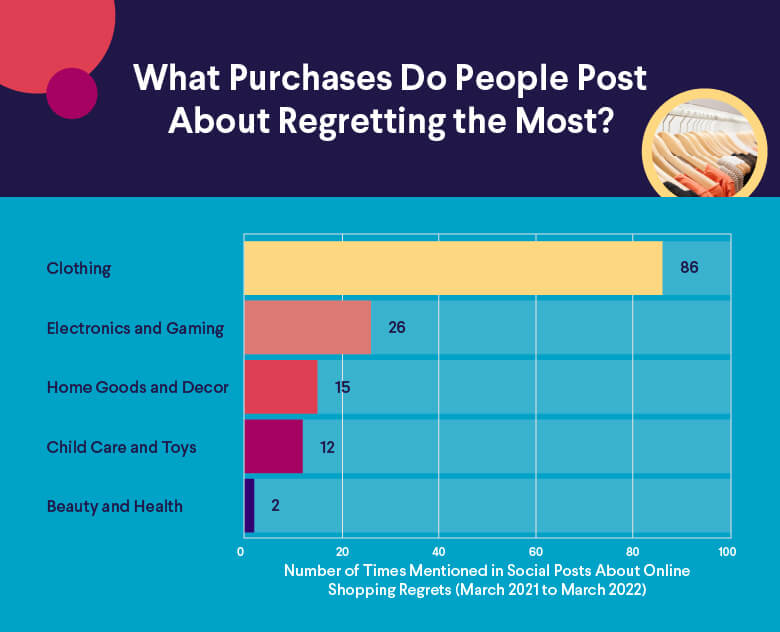
According to the social listening data, people regret buying clothing the most, and they regret buying beauty and health products the least.
11. Buy Now Pay Later: Convenient or confusing?
When looking at social posts about shopping regrets from March 2021 to March 2022, we noticed a spike in negative sentiment in February 2022. The spike was caused by a viral Bloomberg article that discusses the dangers and confusion around buy-now-pay-later (BNPL) options while shopping online.
The article talked about how BNPL models can be misleading about how much they charge consumers, especially compared to credit cards. It discussed how using a buy-now-pay-later option can end up being more expensive than using a credit card.
Buy-now-pay-later is a relatively new concept for online shoppers, but it’s already gained popularity: More than one in 10 of our survey respondents (14%) say they prefer to use a BNPL service to finance their online purchases. If you choose to use buy now pay later, read all the terms carefully and make sure you fully understand how much you’re being charged. You may find that paying with a credit card is a more cost-effective option.
12. Haul videos are an influential source of shopping inspiration.

Our data shows that haul videos are an influential source of shopping inspiration. In fact, one-third of our respondents said the main reason they watch haul videos is to discover new products they might want to buy.
More than half (53%) of our respondents say they’ve bought something they saw on a haul video. When comparing different age groups, younger people appear to be the most influenced by haul videos, with 70% of Gen Zers saying they’ve bought something after watching one. Looking at men versus women, men are more likely to have purchased something they saw on a haul video (60%) than women (46%).
13. Online grocery delivery is here to stay.

While in-store grocery shopping continued during the pandemic, reluctance to be out in public opened the door for more options, such as grocery delivery apps and DIY meal kits.
In fact, 38% of respondents now use grocery delivery services but didn’t before the pandemic. And 48% of people have food or groceries delivered to their house at least once a week. Before the pandemic, only 3% of grocery spending occurred online!
We also found that 22% of people use meal kits such as Blue Apron and Hello Fresh currently, but did not use them before the pandemic.
And on days when people don’t feel like cooking, online food delivery comes to the rescue. In fact, 28% of respondents said they now order meals from services like UberEats and DoorDash but never used to pre-pandemic.
When we asked respondents what they get when ordering food or groceries online, the most common answers were:
• Sweet snacks (such as candy, cookies, ice cream): 45%
• Salty snacks (such as chips, jerky, nuts): 43%
• Vegetables and fruit: 42%
The Takeaway
Mass shutdowns and the reluctance to go out in public made consumers rely more on online shopping during the pandemic. And now that stores have reopened, people plan to continue shopping online at the same rate, or even more.
With so many consumers now embracing the convenience of online grocery and food delivery, leaving the house for necessities may become a thing of the past. One reason people might consider venturing out, however, is to buy new clothing. Nearly half of shoppers still want to try things on before they buy them.
A majority of people say most of their online purchases are impulse buys—and they’ve even forgotten they ordered something until it arrived at their door. Perhaps that has some correlation with the fact that more than half of our survey respondents say they haven’t been sober when shopping online.
There has also an increase in the use of the buy-now-pay-later model, which became popular during the pandemic. In fact, over 10% of our respondents say it’s their preferred payment method when shopping online. But buy-now-pay-later models can be misleading, and may ultimately end up costing buyers more than they expected.
Credit cards offer a similar type of financing, but are typically much clearer in their repayment terms and interest rates. They also often offer rewards.
Photo credit: iStock/AsiaVision
New and existing Checking and Savings members who have not previously enrolled in direct deposit with SoFi are eligible to earn a cash bonus when they set up direct deposits of at least $1,000 over a consecutive 25-day period. Cash bonus will be based on the total amount of direct deposit. The Program will be available through 12/31/23. Full terms at sofi.com/banking. SoFi Checking and Savings is offered through SoFi Bank, N.A. Member FDIC.
SoFi members with direct deposit can earn up to 4.00% annual percentage yield (APY) interest on Savings account balances (including Vaults) and up to 1.20% APY on Checking account balances. There is no minimum direct deposit amount required to qualify for these rates. Members without direct deposit will earn 1.20% APY on all account balances in Checking and Savings (including Vaults). Interest rates are variable and subject to change at any time. These rates are current as of 3/17/2023. Additional information can be found at https://www.sofi.com/legal/banking-rate-sheet
Financial Tips & Strategies: The tips provided on this website are of a general nature and do not take into account your specific objectives, financial situation, and needs. You should always consider their appropriateness given your own circumstances.
SOCC0622017
